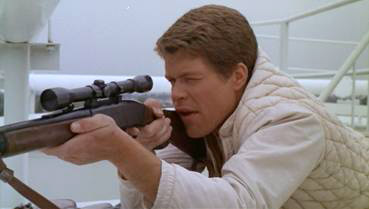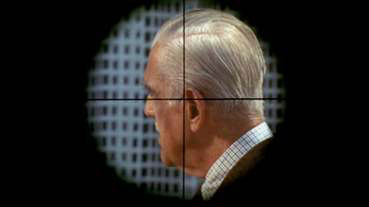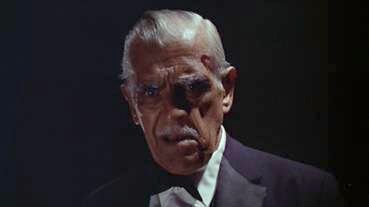"The
world belongs to the young. Make way for them, they
can have it." |
Byron
Orlock |
It's been famously claimed that guns don't kill people, people do.
But when those people use guns to do it, this particular tool – whose primary purpose is to main or kill, after all – has to take a sizeable part of the blame. The issue of
easy availability of firearms in the US has been a contentious
one for as long as I can remember, and any politician who
makes gun control a campaign promise is usually deemed to
be committing electoral suicide. The debate has been irregularly
highlighted by a tragic series of shootings at American
schools, and was pushed into the mainstream by Michael Moore
and the international success of Bowling for Columbine.
But guns remain freely available, and people continue to
die at the hands of those exercising their constitutional
right to bear arms.

Since
its early days, cinema has glamorised and even trivialised
the gun. In movies it's a prop, a tool employed to both complicate and
resolve a narrative thread. If you get shot in the movies, you fall
down, maybe bleed a little, and drop out of the story. Wielded by the good
guys, guns are tools for justice, and when they are used
to kill the innocent it's because they fall into the hands
of the wicked, the naïve, or the mentally unhinged – guns rarely make
it into the news unless they are put to destructive use
by one of these three. This allows those who believe in
the right to bear arms to remain comfortable with the free
availability of deadly weaponry – killing sprees are executed
by insecure loners with a grudge, people not at all like
them or their friends or family. Guns don't kill people,
the socially excluded do.
Oh
really? Time for a brief trip back through not-so-ancient
history.
On
27 November 1978, former policeman and San Francisco city
supervisor Dan White, a well-liked man from what the well-to-do
like to describe as a good background, entered City Hall and shot
Mayor George Moscone, then walked into the office of supervisor
Harvey Milk, the city's first openly gay official, and emptied
five bullets into him. Both victims died of their wounds. White
was sentenced to a mere seven years and eight months and
served less than five. The gun he used was not an issue,
White's lawyer contesting that a diet of junk food – the
notorious 'Twinkie defence' – was responsible for his 'out-of-character'
behaviour.
On
20 August 1989, wealthy businessman Jose Menendez and his
wife Kitty were murdered with a shotgun in the supposed safety of their $4 million
mansion. The crime was reported by their distraught sons
Joseph and Eric. Over the next four months, the two sons
spent over a million dollars of their father's money, and
in March of the following year were arrested and charged
with the killings. At the trial they admitted their crimes,
but claimed they was prompted by years of sexual abuse. The
jury was deadlocked and a mistrial was declared. The second
jury did not believe the brothers' claims and they are found
guilty on two counts of first degree murder.
On
31 July 1966, former Eagle Scout and ex-U.S. Marine Charles
Whitman stabbed his wife and mother to death. The following
day, armed with a sniper rifle, he climbed the Bell Tower
at the University of Texas, and in the space of ninety-six minutes
killed sixteen people and wounded a further thirty before being killed
himself when armed officers stormed the tower.
I
could go on.
And
yet still the movies tell us that it's only those on the
fringes of society that guns turn into killers. Even the
recent Dear Wendy,
an intelligent and well made film, chose to illustrate the danger of
firearm obsession by placing guns in the hands of misfits
and losers. You could be forgiven for wondering when a film-maker
would be brave enough to show that even the most upright,
clean living American boy could, with free access to guns,
turn without warning into a mass murderer. As it happens, you don't have
to wait at all, but take a trip back to 1968 and Peter Bogdanovich's
astonishing first feature, Targets.
The
story of how the film came to be has become part of film
lore. Having directed sequences for Roger Corman's Wild
Angels, Bogdanovich was offered the chance to make
his first feature with the following proviso: he had horror
legend Boris Karloff for two days, twenty minutes of footage
from Corman's own The Terror (starring
Karloff) to incorporate, a budget of just $125,000 ($25,000
of which was earmarked for Karloff) and the rest was up
to him. Which brings us neatly back to the aforementioned Charles Whitman,
whose story was to prove a major influence on Bogdanovich's
film.

Karloff
plays Byron Orlock, an ageing horror star who unexpectedly
announces his retirement because he no longer believes that the period genre tales in which he appears can compete with the true life
horrors of modern society. As if to prove his point, outgoing young
family man Bobby Thompson unexpectedly kills his wife and mother
and takes off with an arsenal of guns, which he uses to
randomly shoot at drivers from the top of a gas storage tower, continuing his spree later at the very drive-in movie theatre at which Orlock is scheduled
to make a personal appearance.
Bogdanovich
connects the two stories at an early stage with a brilliantly
executed chance encounter: as Orlock stands on the sidewalk
cursing the changing times, there is a startling cut to
the image of his head framed in the crosshairs of a rifle
scope. An assassination attempt? No, the rifle is being
held by Bobby in the gun shop opposite and he's just getting
a feel for the weapon before buying it. He doesn't even
recognise the man he has taken aim at – it's the gun shop
owner who identifies Orlock. Despite this ominous introduction,
Bobby is presented from the start as a friendly all-American boy – cheery, good-looking and polite, you could be be forgiven for thinking that he seems the very essence of
responsible gun ownership. But just a few seconds after purchasing the rifle,
he walks to his car and opens the trunk to reveal a terrifying
array of weaponry, all laid out in a compulsively neat display
of potentially lethal firepower. We don't know exactly what,
but something is clearly wrong here. The strength of the
film's portrayal of Bobby is that he is never presented
as obviously unhinged – he cheerfully interacts with his
family, shares a meal and stories of his day ("I saw
Byron Orlock!"), and treats all of them with obvious
love and respect. But increasingly the chinks begin to show:
he arrives home one day and looks around him like he has never
been there before; an attempt to explain to his wife how
feels falls on deaf ears because she is busy
changing for work; and when target shooting he momentarily takes aim at his own father, who loudly admonishes
him about the irresponsibility of his actions. Then, one night, he collects
an automatic pistol from the trunk of his car and takes
it into the house and you know he is only a few steps away
from something terrible.
The
killing of Bobby's family and a delivery boy who's picked the worst time
to call at the house is a genuinely shocking act, carried
out without fuss or emotion. After briefly surveying his work, Bobby cleans up the blood and almost dutifully
places the bodies of his wife and mother in their beds.* When he takes up position on
the gas tower, there is no sign that he has been emotionally
affected in any way by his actions, and after neatly laying
out his guns he pulls out a sandwich and a coke as if on a leisurely duck hunting trip, before randomly taking aim at passing
motorists on the nearby freeway. That these sequences remain
so powerful is down to a deft blend of performance and
technical handling. The presentation is disarmingly matter-of-fact, with no music score or dramatic camera
placement to artificially heighten the menace or tension, and actor Tim O'Kelly, with his good looks and yearbook smile, hits absolutely the right note as Bobby,
never allowing the character's calm resourcefulness to descend
into obvious psychosis, the only exterior sign that anything
is wrong being his almost obsessive chocolate
bar snacking (a reference to White's 'Twinkie defence' perhaps?).
Orlock's
story runs consistently parallel as he hangs out with young director Sammy Michaels (played by Bogdanovich) and
his girlfriend Jenny, who is also Orlock's personal assistant. As Bobby's
story builds to a life-changing climax, Orlock is heading
in the opposite direction. His film career is effectively over, the movies he appears in are weak, and he no longer believes in himself as an actor.
His timing dismays Michaels, whose latest script is designed
specifically to re-invent the careers of both men, but Orlock
won't even read it, despite the high regard in which he
holds its writer. There is an intriguing degree of layering
to these scenes created in part by the casting. As ageing
horror star and ambitious young director respectively, Karloff
and Bogdanovich are playing direct reflections of their true-life personas, and the script Michaels wants Orlock to read
sounds very much like the one for this very film – "I
wrote a hell of a picture for you," Michaels tells
Orlock, "For you as you really are."** But to
assume that by playing a character close to his true self
Karloff is somehow slumming it would be way off the mark.
His performance here is a joy, a beautifully pitched melding of
English politeness and convincing world-weariness that is carried
off with a charm and subtlety that not only makes Orlock
sympathetic and engaging, but gives rise to some delicious character moments: the slight pause and eye-roll he gives at the drive-in when he suggests that they wait for Michaels' arrival by actually watching the film; his post-drinking start at catching himself in the mirror; the camp-fire horror tale with which he entrances his younger companions.

The two stories dovetail seamlessly at a climax (both parties arrive at the drive-inthrough logical and believable plot development), which retains to this day an astonishing sense of terror
in the dark, the traditional figure of the murderous bogeyman
brought starkly into the modern age as victims are selected
almost at random and killed at a distance, their deaths
preceded by a sharp intake of breath, and a gunshot drowned
out by the soundtrack of the movie. This collision of
stories peaks in an extraordinary confrontation
between the two men, where a confusion of reality and film prompt
the only real panic that Bobby ever displays. The last words
of both men are memorable, as Orlock reflects on his own
fears, while Bobby is more concerned with the accuracy of his shooting.
It's
a hell of a finale to a film that transcends its low budget and B-movie origins, and which stands today as one of the most intelligent,
gripping thrillers of its era, and one that is both still relevant and, by today's standards at least, a model
of impact through restraint. Others will disagree, but for
my money Targets showcases both Karloff
and Bogdanovich at their very best. There's a down
side to this, of course, both for an actor who could have shone brightly in
his later years if he had been offered more such roles,
and for a director just starting out who, despite some strong
work in the following few years, would never make a film
of such breathtaking immediacy again.
Framed
1.78:1 and anamorphically enhanced, this is a solid transfer,
recreating the film's specifically designed colour scheme
(warm colours for Orlock's scenes, colder colours for Bobby)
well, with contrast and black levels pretty much bang on.
There are a few dusts spots and dirt marks here and there,
but otherwise the print is in good shape, and certainly
looks a lot better than the tiny budget would lead you to
expect.
The
Dolby 2.0 stereo soundtrack is not the most dynamic on the
block and does show its age in that respect, though dialogue
and sound effects (there is no music score) are still very
clear.
The
main extra here is a Commentary
by director Peter Bogdanovich. An early member of what came
to be known as the Film Generation, directors who learned
their craft by watching and studying the films of their
cinematic heroes, Bogdanovich was also a writer for film
magazines and had interviewed and even made friends with
many of the film-makers he admired. There are thus a fair
few tales of how he put their advice into practice, something
many working in film nowadays will probably identify with
(fellow reviewer Camus, a working editor and occasional
director, freely admits that one of his own rules of editing
was learned from Hitchcock), but there is plenty of other
information offered up, from the illegal freeway filming
and the lies told to gun shop owners about the film's story,
to the links to (and quotes from) the Charles Whitman case.
He clearly loved working with Karloff, and pays tribute
to sound editor Verna Fields – who went on to cut Medium
Cool, Paper Moon, Sugarland
Express and Jaws – and assistant
director Frank Marshall, who later became a producer
and director of considerable note, plus later M*A*S*H
regular Mike Farrell, unrecognisable in his first film role
as the a drive-in shooting victim. But the most surprising
revelation is that his script was essentially re-shaped
into its present form by the late, great Samuel Fuller,
who refused to take credit for his work but was clearly
the brains behind some of the film's most memorable moments.
There
is also an Introduction by Peter
Bogdanovich, or at least that's what it's called here –
it's actually more an overview of the project, a compressed
version of the commentary that, though interesting in itself,
essentially repeats information supplied there. It's definitely
not one to watch before seeing the film for the first time.
How
can I be even remotely objective about Targets?
When I first caught it, many years ago, I was stunned. I
had come at Bogdanovich's work from the wrong direction,
from Nickelodeon and At
Long Last Love – neither of which I enjoyed – only later catching up with Paper
Moon and The Last Picture Show.
I could not believe that Targets was made
by the same director, and at the very start of his career.
Years later, presented so well on DVD, it stands the test
of time magnificently, shaming later films in its subtle
handling of a potentially sensationalist subject, in the process bringing
a real sense of horror to a story dragged almost literally
from the headlines. The presentation on Paramount's region
1 DVD is very good, and though I have not been able to check,
the region 2 release is apparently identical. Either way,
genuinely essential outsider cinema.
*
This was based on reports of Charles Whitman's actions after
killing his wife and mother.
**
This set-up also plays as a (probably accidental) reading
of the horror genre as it stood circa the film's release,
Orlock's career reflecting the decline of the once-dominant
Hammer studios, whose seemingly endless reworking of their
classic monster series was seen as increasingly out of touch
with an audience that was becoming tuned to the contemporary
urban horrors of Repulsion, Rosemary's
Baby and Night of the Living Dead.
|